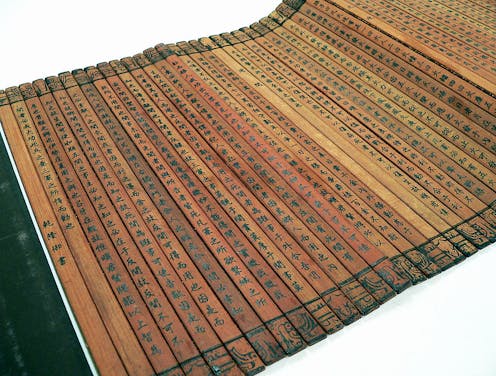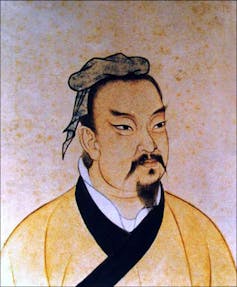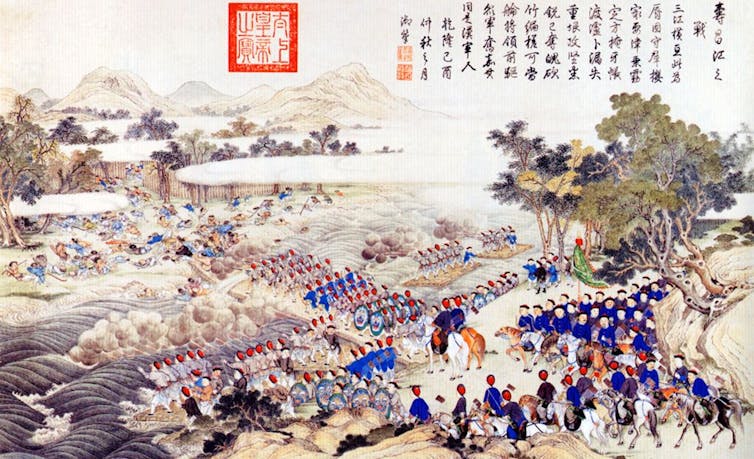Sunzi, 'shì' and strategy: How to read 'Art of War' the way its author intended
The ancient Chinese text is considered a military classic, but Western readers often overlook its philosophical roots.

In the mid-1990s, I picked up the military classic “Art of War” hoping to find insight into my new career as an officer in the United States Marine Corps.
I was not the only one looking for insights from the sage Sunzi, also known as Sun Tzu, who died over 2,500 years ago. “Art of War” has long been mined for an understanding of China’s strategic tradition and universal military truths. The book’s maxims, such as “know the enemy and know yourself,” are routinely quoted in military texts, as well as business and management books.
Initially, I was disappointed. It seemed Sunzi’s advice was either common sense or in agreement with Western military classics. However, a few years later the Marine Corps trained me as a China scholar, and I spent much of my career working on U.S. policy in the Indo-Pacific region. This deepened my desire to understand how leaders in the People’s Republic of China see the world and choose strategies. Looking for insight, I turned to classical Chinese philosophy and finally encountered concepts that helped illuminate the unique perspective of Sunzi’s “Art of War.”
Today, I am an academic researching how Chinese philosophy and foreign policy intersect. To comprehend “Art of War,” it helps readers to approach the text from the worldview of its author. That means reading Sunzi’s advice through the prism of classical Chinese metaphysics, which is deeply shaped by the philosophy of Daoism.
Daoist roots
China’s intellectual tradition is rooted in the Warring States period from the 5th to 3rd century B.C.E., the era during which Sunzi is thought to have lived. Though a time of conflict, it was also a time of cultural and intellectual development that led to the rise of Daoism and Confucianism.

Confucian philosophy focuses on maintaining proper social relationships as the key to moral behavior and and social harmony. Daoism, on the other hand, is more concerned with metaphysics: trying to understand the workings of the natural world and drawing analogies about how humans should act.
Daoism views existence as composed of constant cycles of change, in which power ebbs and flows. Meanwhile, the “Dào,” or “the way,” directs all things in nature toward fulfilling their inherent potential, like water flowing downhill.
Helping nature take its course
The Chinese word for this concept of “situational potential” is 勢, or “shì” – the name of Chapter Five in “Art of War.” Almost every Western version translates it differently, but it is key to the military concepts Sunzi employs.
For example, Chapter Five explains how those who are “expert at war” are not overly concerned with individual soldiers. Instead, effective leaders are able to determine the potential in the situation and put themselves in position to take advantage of it.
This is why later chapters spend so much time discussing geography and deployment of forces, rather than fighting techniques. One does more to damage an opponent’s potential by undermining their scheme than by merely killing their soldiers. Sunzi is concerned about long supply lines, because they lower an army’s potential by making it harder to move and vulnerable to disruption. A general who understands potential can evaluate troops, terrain and scheme, then arrange the battlefield to “subdue the enemy without fighting.”

In Daoist thought, the correct way to manage each situation’s potential is to act with 無為, “wúwéi,” which literally translates as “nonaction.” However, the key idea is to disturb the natural order as little as possible, taking the minimum action needed to allow the situation’s potential to be fulfilled. The term does not appear in “Art of War,” but a contemporary reader of Sunzi’s would have been familiar with the connection between nurturing “shì” and acting with “wúwéi.”
The importance of acting with “wúwéi” is illustrated by the Confucian philosopher Mengzi’s story about a farmer who pulled on his corn stalks in an attempt to help them grow tall, but killed the crop instead. One does not help corn grow by forcing it but by understanding its natural potential and acting accordingly: ensuring the soil is good, weeds are removed and water is sufficient. Actions are most effective when they nurture potential, not when they try to force it.
From the battlefield to the UN
In a Daoist understanding, leaders hoping to chart an effective strategy must read the situation, discover its potential, and position their armies or states in the best position to take advantage of “shì.” They act with “wúwéi” to nurture situations, rather than force, which could disturb the situation and cause chaos.
Therefore, in foreign policy, a decision-maker should attempt to make small policy adjustments as early as possible to slowly manage the development of the international environment. This approach is evident in Beijing’s use of “guānxì.” Meaning “relationships,” the Chinese term carries a strong sense of mutual obligation.
For example, the PRC waged a decadeslong effort to take over the United Nations “China seat” from Taiwan, where the Republic of China government had fled after Communists’ victory in the civil war. Beijing accomplished that by slowly building friendships, identifying shared strategic interests and accruing owed favors with many small states around the world, until in 1971 it had enough votes in the General Assembly.
Trend-watching today
The concept of “shì” also provides a lens for understanding the PRC’s increasing pressure on Taiwan, a self-ruled island that Beijing claims is its own territory.

Sunzi might say that discerning the current trend in the Taiwan Strait is more essential than conventional questions about comparative military strength. Several factors could push Taiwan closer to Beijing, including the island’s loss of diplomatic allies and the pull of the PRC’s massive economy – not to mention Beijing’s growing global clout vis-à-vis the U.S. If so, shì is in Beijing’s favor, and a nudge to persuade the U.S. to stay out is all that is needed to keep the situation developing to the PRC’s advantage.
Or is the potential developing in the other direction? Such factors as a growing sense of a unique Taiwanese identity and the PRC’s troubled economic model may make closer ties with the mainland less and less appealing in Taiwan. In that case, Beijing may see a need to appear strong and dominant so Taiwan will not be lulled into counting on support from Washington, D.C.
A surface reading of Sunzi can easily support an emphasis on troop deployments, intelligence and logistics. However, an understanding of “shì” highlights Sunzi’s emphasis on evaluating and nurturing situational potential. It is not that the former are unimportant, but a decision-maker will use them differently if the goal is to manage situational trends rather than seek decisive battle.
That “Art of War” continues to top sales lists demonstrates its lasting appeal. However, to be useful as a guide to understanding security policy and strategy, my experience in the Indo-Pacific region suggests one must dig into the principles that shaped Sunzi’s view of the world and continue to shape the view of leaders in Beijing.
Scott D. McDonald receives funding from the Sara Scaife Foundation, Eisenhower Institute, Charles Kock Foundation, and Taiwan Ministry of Foreign Affairs.
Read These Next
Drones, physics and rats: Studies show how the people of Rapa Nui made and moved the giant statues –
The mysteries of Easter Island, subjects of speculation for centuries, yield to scientific inquiry.
As US hunger rises, Trump administration’s ‘efficiency’ goals cause massive food waste
Despite the administration’s claim of streamlining the government to make its operations more efficient,…
George Plimpton’s 1966 nonfiction classic ‘Paper Lion’ revealed the bruising truths of Detroit Lions
George Plimpton, then a 36-year-old literary editor, endured the brutal realities of a professional…





